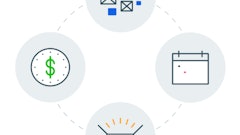Company looks to reduce costs, improve responsiveness to customer demands using webMethods integration backbone
Fairfax, VA — November 7, 2005 — ICI Paints has deployed a solution from webMethods as the foundation for the company's next-generation B2B integration infrastructure, with an eye toward improving the service levels and responsiveness offered to its largest customers while reducing transactional costs.
One of the international businesses of the $9.7 billion ICI group, ICI Paints produces and distributes such paint and decorative products brands as Dulux, Cuprinol and Polycell. Due to the market's highly competitive nature, ICI Paints believes that it is crucial that the company extend its ability to quickly respond to new customer requirements.
Until recently, these efforts were constrained by ICI Paints' continuing reliance on traditional B2B exchange mechanisms, which typically meant that communications were undertaken using EDI (electronic data interchange) over expensive VANs (value added networks). For other customers, orders were processed manually via telephone and fax.
Reducing VAN Costs
By standardizing on webMethods' Enterprise Services Platform as the integration backbone supporting these operations, ICI Paints has been able to reduce the EDI VAN costs typically borne by its customers. The solution offers support for the exchange of major file types, including TRADACOM, EDIFACT, XML and flat files across a number of communication protocols, such as EDIINT /AS2 and FTP.
Ultimately, ICI believes that this approach will allow the company to use fewer resources to accept and process orders from these customers, with this system even being used to exchange documents with ICI Paints' own Stores group, technically considered as another "virtual" customer.
"One of the pillars of ICI's strategy is a strong technology and innovation platform," said Anne Sharp, IT Director at ICI Paints. "In that respect, it made eminent sense for us to further our deployment of webMethods so that it could serve as the foundation of a solid and resilient B2B integration infrastructure."
Benefits for Customers
Sharp said that through this process the company has been able to automate the exchange of orders, acknowledgement of receipts and delivery of advanced shipping notices and invoices with four key customers who generate several hundred orders every day. "This enables us to process orders faster and more efficiently, which ultimately benefits our customers," she said.
The deployment at ICI also extends the company's commitment to webMethods' Fabric solution, which includes the Enterprise Services Platform and which was initially used at ICI for integrating the company's customer relationship management operations with its external supply chain.
Sharp said that the key benefits of using webMethods have been its flexibility and versatility, which have enabled the company to more quickly respond to its customers' desire to find a replacement communication mechanism for the VANs and also to reuse portions of the integration code as they have integrated one customer after the other.
Lowering Integration Expenses
"At the same time, whilst being flexible, webMethods Fabric has also proven to satisfy our most stringent security requirements around B2B communication," Sharp added.
Martyn Eley, webMethods' senior vice president and general manager for the EMEA region, said that the company's success with ICI Paints has already led ICI Paints to contemplate a number of additional projects that can be undertaken using webMethods Fabric. "This is enabled by the essential flexibility and completeness that is inherent in the product suite," Eley said. "By doing so, ICI Paints is able to more readily respond to changes in its business while continuing to lower long-term integration costs."
Additional Articles of Interest
— Increased opportunities for customer interaction create new operational challenges for Sales, Marketing and Service — the Demand Chain. Organizations must look beyond technology to the true foundation of creating and managing demand. For more information, read the SCDExec.com exclusive "Trends in the Demand Chain."
— Got MRO? Then you'll want to read these tips for implementing a strategic approach to sourcing non-strategic categories. Read "Managing the MRO Monster," an SDCExec.com exclusive.
— For seven tips to improve regulatory compliance, reduce operating expenses and streamline global supply chains, read the SDCExec.com exclusive, "Cross-border Trade: Keeping on Top of Customs Regulations."
Fairfax, VA — November 7, 2005 — ICI Paints has deployed a solution from webMethods as the foundation for the company's next-generation B2B integration infrastructure, with an eye toward improving the service levels and responsiveness offered to its largest customers while reducing transactional costs.
One of the international businesses of the $9.7 billion ICI group, ICI Paints produces and distributes such paint and decorative products brands as Dulux, Cuprinol and Polycell. Due to the market's highly competitive nature, ICI Paints believes that it is crucial that the company extend its ability to quickly respond to new customer requirements.
Until recently, these efforts were constrained by ICI Paints' continuing reliance on traditional B2B exchange mechanisms, which typically meant that communications were undertaken using EDI (electronic data interchange) over expensive VANs (value added networks). For other customers, orders were processed manually via telephone and fax.
Reducing VAN Costs
By standardizing on webMethods' Enterprise Services Platform as the integration backbone supporting these operations, ICI Paints has been able to reduce the EDI VAN costs typically borne by its customers. The solution offers support for the exchange of major file types, including TRADACOM, EDIFACT, XML and flat files across a number of communication protocols, such as EDIINT /AS2 and FTP.
Ultimately, ICI believes that this approach will allow the company to use fewer resources to accept and process orders from these customers, with this system even being used to exchange documents with ICI Paints' own Stores group, technically considered as another "virtual" customer.
"One of the pillars of ICI's strategy is a strong technology and innovation platform," said Anne Sharp, IT Director at ICI Paints. "In that respect, it made eminent sense for us to further our deployment of webMethods so that it could serve as the foundation of a solid and resilient B2B integration infrastructure."
Benefits for Customers
Sharp said that through this process the company has been able to automate the exchange of orders, acknowledgement of receipts and delivery of advanced shipping notices and invoices with four key customers who generate several hundred orders every day. "This enables us to process orders faster and more efficiently, which ultimately benefits our customers," she said.
The deployment at ICI also extends the company's commitment to webMethods' Fabric solution, which includes the Enterprise Services Platform and which was initially used at ICI for integrating the company's customer relationship management operations with its external supply chain.
Sharp said that the key benefits of using webMethods have been its flexibility and versatility, which have enabled the company to more quickly respond to its customers' desire to find a replacement communication mechanism for the VANs and also to reuse portions of the integration code as they have integrated one customer after the other.
Lowering Integration Expenses
"At the same time, whilst being flexible, webMethods Fabric has also proven to satisfy our most stringent security requirements around B2B communication," Sharp added.
Martyn Eley, webMethods' senior vice president and general manager for the EMEA region, said that the company's success with ICI Paints has already led ICI Paints to contemplate a number of additional projects that can be undertaken using webMethods Fabric. "This is enabled by the essential flexibility and completeness that is inherent in the product suite," Eley said. "By doing so, ICI Paints is able to more readily respond to changes in its business while continuing to lower long-term integration costs."
Additional Articles of Interest
— Increased opportunities for customer interaction create new operational challenges for Sales, Marketing and Service — the Demand Chain. Organizations must look beyond technology to the true foundation of creating and managing demand. For more information, read the SCDExec.com exclusive "Trends in the Demand Chain."
— Got MRO? Then you'll want to read these tips for implementing a strategic approach to sourcing non-strategic categories. Read "Managing the MRO Monster," an SDCExec.com exclusive.
— For seven tips to improve regulatory compliance, reduce operating expenses and streamline global supply chains, read the SDCExec.com exclusive, "Cross-border Trade: Keeping on Top of Customs Regulations."
- More articles about webMethods.

























